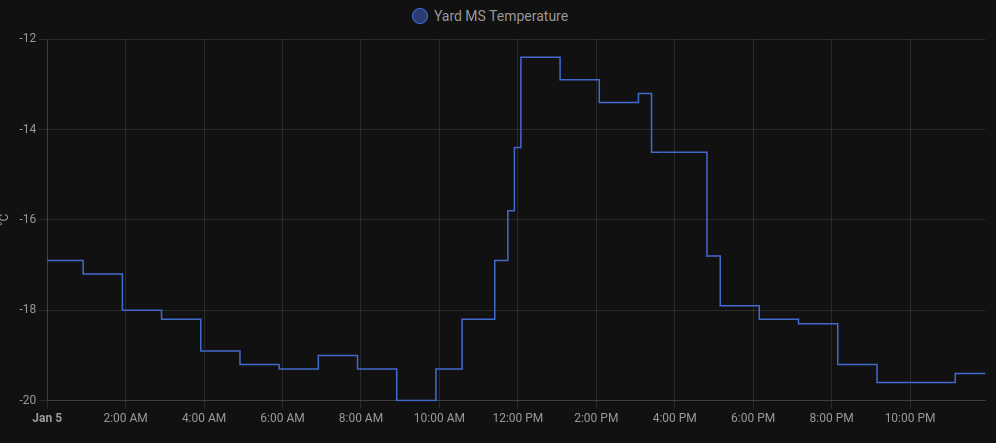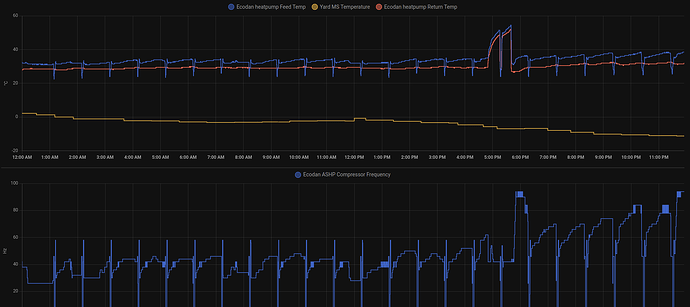curious how it works with 2 boosters. Can you explain your setup a bit?
It’s fairly simple. Outdoor unit: PUD-SHWM100YAA (modified to PUD-SHWM120YAA) & indoor unit EHST20D-YM9D equipped with FTC6 . The pump is running on Room Temperature using Wireless Controller.
The indoor unit has 2 boosters built in: 3kW & 6kW. Down to -15C the outdoor unit is enough to meet the required flow temperature. Now lets say that outdoor temp goes down to -17C. The flow setpoint is 45C, but being so cold outside the outdoor unit cannot provide more than 40C. That’s when the Heat pump decides to kick in the 3kW booster to help raise the flow temperature. As soon the flow reaches 43C the booster turns off. When the flow temp decreases the booster kicks in again. So it’s on and off based on the flow temp.
Now imagine -20C outside. The outdoor unit cannot provide more than 37C flow, but the heat pump wants 47C. First kicks in the 3kW booster and helps the flow up to 43C. Then 3kW booster turns off and the 6kW turns on to provide additional power for the flow to go up. They are not on all the time, they turn off when the flow setpoint is reached. On and off every few minutes.
But when we get -28C outside both boosters stays on all the time even during the defrost cycle.
For me it is kind of a big deal to know when the boosters are on because I run automations i Home Assistant that starts and stops the electrical car charging based on temperature outside and if the boosters are on or off. I have 3 phase 25A at home but still not enough when god open the freezer.
Hi Greg,
What country are you in, if you don’t mind saying?
My wife is from Latvia and I have been in -28c a few times.
Not nice for heating but not as bad outside as it sounds if you dress appropriately.
I remember once in November in Riga, Independence day celebrations and we were on a bridge over the Daugava watching fireworks, about 3c but wet and windy, I swear it felt worse than -28c!
Sweden. Somewhere in the middle of the country. For 6 days in a row we had in between -20 and -24C during the night. -13 to -18C during the day. Every room in my house has 22C so who cares what temp is outside.
P.S. Here you can see how the boosters worked between 12pm-4PM today
Nice.
I have spent a lot of time there too. Mostly around Hassleholm, sawmilling.
I have been as far north as Ostersund
7 posts were split to a new topic: Heat pump size as a soft setting
Wow, what COP do you have at these temperatures ?
Seems lot of manufacturers are doing this trick but from what I read so far it’s at least Daikin, Mitsubishi and Samsung so I guess all are doing this. Wish I had more knowledge at the beginning but nobody tells you. Even installers have no idea.
I agree, maybe Tim @Timbones can move it into separate topic discussion “COP at extreme temperatures” ? ![]()
1.53 CoP is including additional booster heater ? Still pretty good if we consider such low outside temps. Here we have -5 to -10C at most for couple of days in Winter so it’s hard for me to estimate how my pump would perform in such condition. Lowest average temperature here this year was -2.8C and I had COP 2.16.
whats the monthly consumption ? 150 kWh ![]() in a day, jikes.
in a day, jikes.
January 2024 → 4,700.26 kWh
December 2024 → 3,062.49 kWh
![]()
Edit: This is the total energy used for the whole house including charging the EV
Crazy… What was the flow temperature at that COP ?? I have 2.16@-3C ![]()
At 0C - flow 32C - return 28.5 - dT 3.5 - compressor frequency 58Hz
At -11C - flow 38C - return 32.5 - dT 5.5 - compressor 90Hz
Compressor can reach maximum 118Hz.
Such high COP with so many defrost cycles ? Crazy. How many emitters do you have and what types ? You must have a really big surface area. With mine 10x Type 21 radiators no way I can go below 38C flow since there are pretty inefficient at such low temperatures. I would need at least Type 22 but I don’t want to replace them since I doubt it’s rentable.
Ha ha! True that! Sometimes, I can’t even find my kids in the house.
I have a combination of floor heating in 2 rooms + 2 fan coils + 2 bathroom radiators + 12 Type 22 radiators. The old heating pump was 70/50 but few years ago I replaced it with Mitsubishi + 500 L buffer tank and that’s when i redid the whole pipe works. I replaced every single pipe in the house and i replaced the radiators. I ran all the calculations for 45/35, this means that radiators are oversized. The difference I paid for bigger radiators it already paid itself by saving electricity.
I have a steady 22C in every single room (controlled by TRVs) except for bathrooms where I have 25C (no TRV, fully open). In the basement i have 10-15C depending on outside temperature.
P.S Luckily we were off today in Sweden so I could sit here and write this magical tale about my heating system ![]()
Hehe, that explains it so I won’t envy you because I believe it was not cheap ![]() Good job anyway. But in your case with this artic climate it makes sense to oversize and it will pay off sooner or later. But in our almost “subtropical” climate (hehe, it was not always like this but this global warming you know…) I doubt it would ever pay off. Replacing 10x type 21 rads with type 22 would cost me maybe 2000 eur and instead of SCOP3 I would maybe reached SCOP4 ? No idea what difference this would make but maybe not too big. I even don’t have buffer. So when I need 10MW per year I would say savings would be 1MW per year so this is around 140 eur. Now I’ve installed FVE so the benefit would be even lower. So it would return maybe in 20 years when I can replace the radiators again
Good job anyway. But in your case with this artic climate it makes sense to oversize and it will pay off sooner or later. But in our almost “subtropical” climate (hehe, it was not always like this but this global warming you know…) I doubt it would ever pay off. Replacing 10x type 21 rads with type 22 would cost me maybe 2000 eur and instead of SCOP3 I would maybe reached SCOP4 ? No idea what difference this would make but maybe not too big. I even don’t have buffer. So when I need 10MW per year I would say savings would be 1MW per year so this is around 140 eur. Now I’ve installed FVE so the benefit would be even lower. So it would return maybe in 20 years when I can replace the radiators again ![]() But I have to admin SCOP hunting addiction is real
But I have to admin SCOP hunting addiction is real ![]()




